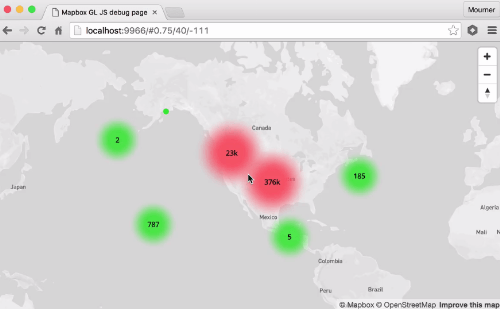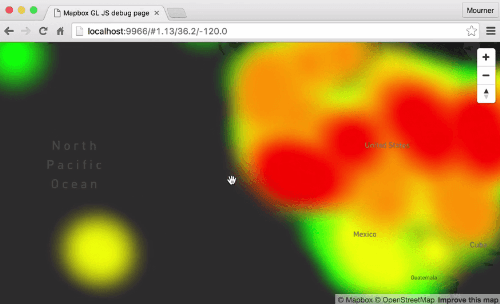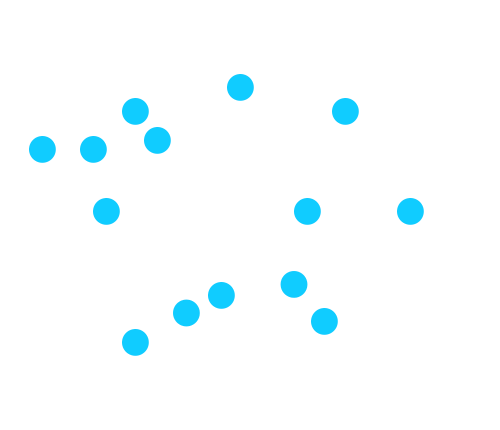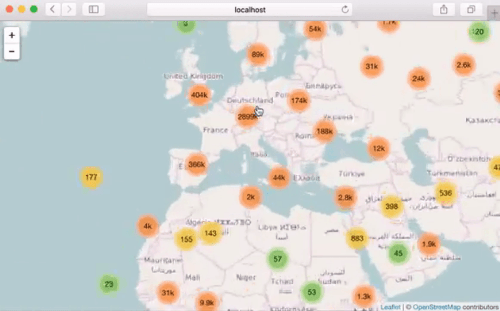本文主要内容来自Mapbox官方博客,感兴趣的童鞋可以点击此处浏览原文。
在线地图上浏览点数据最常见的应用需求之一,众多JS库(Leaflet、Openlayers、Mapbox、Mapzen、CARTO等等)都可以很轻松地实现。然而,但点数据规模达到一定程度后,直接对每个点进行渲染是不现实的,尤其是在点数据集达到百万级以上的时候。
Mapbox GL JS提供了point clustering功能,可使浏览器迅速完成400,000点数据的处理:

通过样式修改,还可将其转化为热力图表达:

在这项功能背后,是一个名为Supercluster的JavaScript聚类库,下面将该库的实现思路进行介绍。
层次贪心聚类
在某个特定缩放层级上,对点数据集进行聚类时,最直接的方法就是贪心聚类,流程如下:
- 选择点数据集中的任意一点;
- 以该点为中心,查找一定范围内的所有点;
- 通过上一步找到的邻近点生成一个点簇;
- 选择已生成点簇以外的某个点,重复上述步骤。

然而,在每一级地图上使用贪心聚类的代价太高,每变化一次缩放级别就得重新聚类一次,并且随着地图的放大,点簇的数目会呈指数级增长。
考虑到不同层级的点簇之间存在着关联,很自然地可以想到重复利用聚类结果。比如从18级到17级,可以将18级的聚类结果进行分组合并。随着地图的缩小,需要处理的点簇也会呈指数级下降,这样整个聚类过程就会快很多。

这种方法也就是层次贪心聚类,它已经被Dave Leaver实现为Leaflet.markercluster,Leaflet的常用插件之一。
尽管这种方法很简单,但已足够用来处理浏览器中的百万级点数据集了,也足以满足交互式地图浏览的需求。
点簇索引
当然,交互式地图中的层次贪心聚类实现依然存在两类代价高昂的操作:
- 查找一定范围内的所有点;
- 查找屏幕内的所有点簇。
范围查询最简单的实现方式就是遍历所有点,然后保存处于查询范围内的点。但是如果对每个潜在点簇进行查询,效率还是会很低。同样地,当用户拖拽或缩放屏幕时,也没有必要去遍历屏幕以外的点了。
为了使上述两类操作更加高效地完成,我们必须使用空间索引,将点数据集一次性地组织为特定的数据结构,之后就能实现任意数量的实时查询。
空间索引是许多算法必不可少的部分,所以已经出现许多JavaScript库实现了快速空间索引,比如RBush。
虽然在每个缩放级别都需要对点数据集建立一次索引,但是这样可以在任意缩放级别都实现实时查询与浏览。
聚类性能实验
下面是对400,000个点进行聚类的实验结果:
Supercluster在1s内就完成了该数据集的聚类处理。而且使用Web Worker来完成该处理过程的话,不会影响主线程中的地图渲染过程。而当聚类完成后,任何范围查询都可以实时完成(1ms内)。
Supercluster使用方法
Supercluster API很简洁:
由于Supercluster在Mapbox GL JS中表现出来的性能非常好,官方很大方地将其发布为一个独立的JavaScript库,以便于其它软件充分发挥该库的作用。

此外,也可以使用Node.js在服务器端进行聚类处理,然后通过Anand Thakker开发的vt-pbf module,将聚类结果转换为Mapbox矢量瓦片。
实际上,Supercluster也就300多行代码,是很好的学习素材。